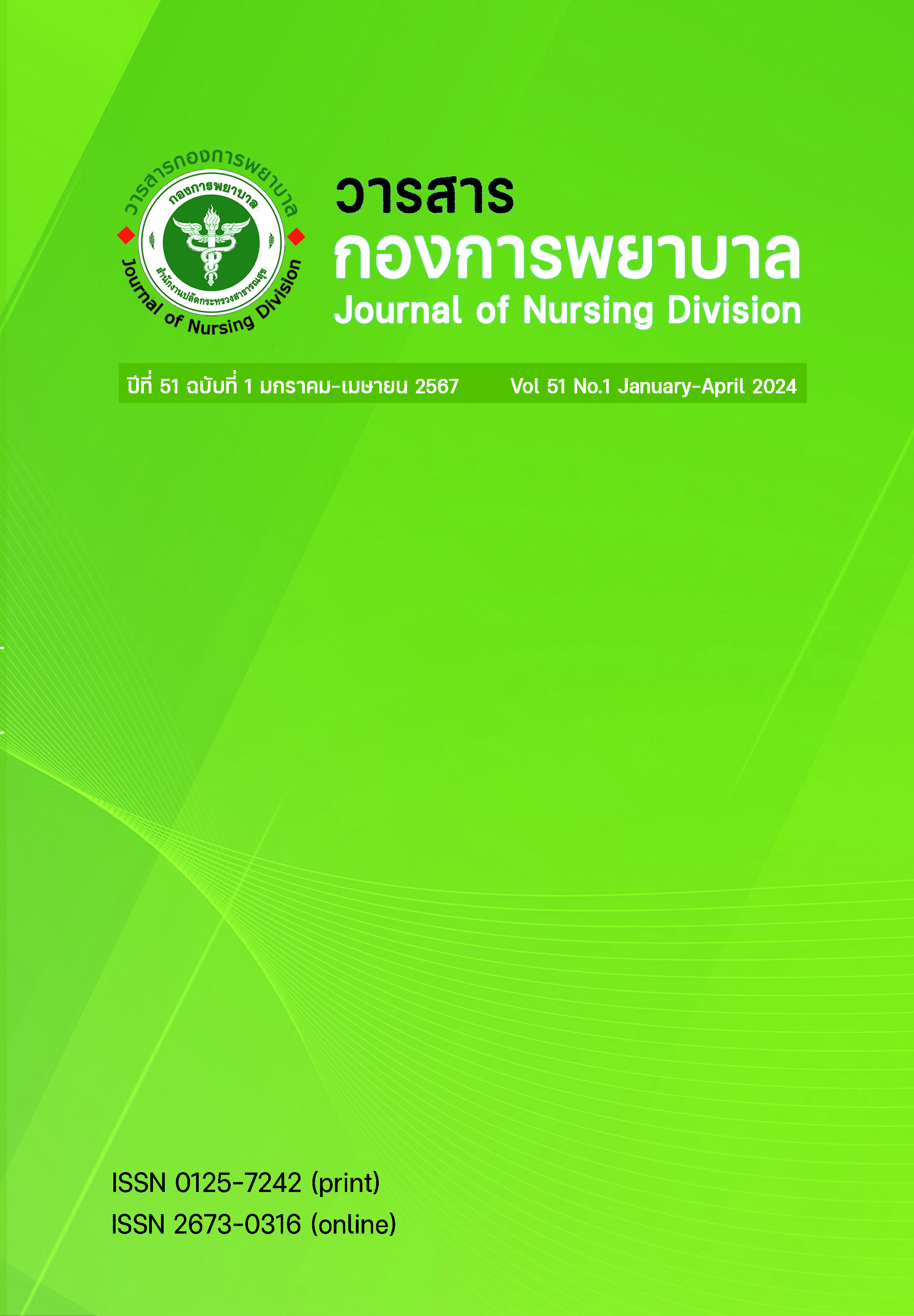Development of Clinical Supervision Model among Mechanically Ventilated Patients in Medical Intensive Care Unit, Hatyai Hospital
Main Article Content
Abstract
Abstract
This research and development aimed to develop and evaluate the use of a clinical supervision model of mechanically ventilated patients, medical intensive care unit. A sample consisted of 32 nurses working in the medical intensive care unit, divided in to 10 nurse-supervisors and 22 nurse-supervisees; and 580 mechanically ventilated patients, equally divided into 290 samples in before and 290 samples in after development group. There were 4 steps: (1) survey problems and development needs, (2) study of concept, theory, possibility, design, and method, (3) tryout and development, and (4) evaluation of using the model. The research tool was the clinical supervision model. Data collection tool consisted of the clinical supervision evaluation form of the nurse-supervisors, nursing practice competency assessment form of the mechanically ventilated patients, and nursing results record form; yielding Index of concordance (IOC) of 0.86, 0.87, and 0.88, respectively and Cronbach's alpha coefficient of 0.84, 0.86, and 0.85, respectively. Data were analyzed using mean, standard deviation, paired t-test and Mann-Whitney U test.
The results revealed that this clinical supervision model for mechanically ventilated patients consisted of (1) nursing practice guidelines for mechanically ventilated patients, (2) supervision manual, (3) coaching manual, and (4) nursing principles and ethics manual. The results on using the clinical supervision model for mechanically ventilated patients found that nurse-supervisors had significantly increased score on knowledge and clinical supervision skills (p < 0.001). Nursing practice for mechanically ventilated patients of the nurse-supervisees had significantly increased (p < .001). For patient outcomes, it was found that the rate of ventilator associated pneumonia significantly decreased (p < .001), the rate of unplanned extubation significantly decreased (p < .001), the rate of ventilator weaning significantly increased (p < .001, and the average duration of using mechanical ventilator significantly decreased (p < .001).
Article Details

This work is licensed under a Creative Commons Attribution-NonCommercial-NoDerivatives 4.0 International License.
References
Reference
Healthcare Accreditation Institute (Public Organization). Hospital and Health Service Standards, Edition 4. Nonthaburi: D-One Book; 2018.
Tana P, Kanokrat S, Trakulsithichoke S. Effects of clinical supervision on the application of nursing process in caring of diabetic patients and nurses’ satisfaction. Journal of Nursing and Health Care. 2017; 35: 52-60.
Statistics on indicators of medical intensive care units. 2023.
Ratchaneewan Chutrakul, Pitchayapan Chantra, Patcharee Yimyaem, Sureeporn Kumpaka, Ratchanee Namchantra. Development of a clinical supervision model for nursing care of patients with severe bloodstream infection syndrome. Journal of Cardio-Thoracic Disease. 2019;30(2): 193-209.
Proctor B. Training for the supervision alliance attitude, skills and intention, in J.R. Cutcliffe T. Butterworth and B. Proctor (ends), Fundamental Themes in Clinical Supervision, London: Routledge. 2001; 25–46.
Chanpen Niamwan, Dueanram Rueangsaen and Warathip Kaenkarn. The Professional Nurses’ Competencies in Nursing Patients Using Mechanical Ventilation. Journal of Nursing and Health Care. 2020 ;38(1): 16-14.
Chanpen Niamwan and Dueanram Rueangsaen. Competency in managing care for patients using ventilators. of professional nurses Nopparat Ratchathani Hospital. Vachirasan Nursing. 2018; 20(2): 1-12.
Alexander G. Behavioral coaching-the GROW model In Passmore, Jonathan.Excellence in coaching: The industry guide. (2nd ed.). Philadelphia: Kogan. 2010.
Niphada Tharipian, Thitinan Wattanachai, Monporn Chatchamni. Effectiveness of using the Patient’s Ventilator Care Protocol. Journal of Nursing and Health Care 2019; 37(1):70-79.
Sasithorn Bampenphon. The Effect of Clinical Supervision Model in Nursing Care Process for Nurse. Hua Hin Medical Journal. 2023; 3 (3)
Kanya Liankruea, Supaporn Payunmahisorn, and Sirikul Karuncharernpanit. The Development of Clinical Supervision Model for Ventilator Associated Pneumonia Prevention among the Intensive Care Unit in Phaholpolpayuhasaena Hospita. Journal of Roi Kaensarn Academi. 2022; 7 (9): 300-316.
Boonjai Srisathitnarakun. Nursing research methods. Bangkok: You &I Intermedia. 2012.
Rattana Buasan. Qualitative research in education, Bangkok: Chulalongkorn University. 5th edition. 2015.
Ruammek, L. (Producer). Clinical Supervision under nursing standards. General Meeting 2020 of Thailand Nursing Association. 2020.
Phongphan Thana, Kanokrat Saengampai, Suthisri Trakulsittitchoke. Effects of clinical supervision on the use of the nursing process in caring for diabetic patients. and nurse satisfaction. Journal of Nursing and Health Care. 2017;35(4): 52-60.
Mathuros Tantiwet, Areerat Khamyu and Pranom Otakanon. Development of a nursing supervision model for nursing inspectors outside of official hours. Buddhist hospital. Faculty of Nursing Journal Burapha University. 2017; 25(3)): 41-51.
Kanya Liankruea, Supaporn Prayoonramahisorn and Sirikun Karuncharoenphanit. Development of a clinical nursing supervision model to prevent pneumonia. from using a ventilator in the intensive care unit Phahonyothin Phonphayuhasena Hospital. Journal of Roi Kaensarn Academi. 2022; 7(9): 300-316.
Nonglak Kam Phatsorn, Suwinee Wiwatwanich. The results of Clinical supervision program for pressure sores of patients and their satisfaction with their supervision Professional nurse. Nursing Division Journal. 2016; 43(3): 44-58.
Michelle CG, Kerry JI, Deborash S. Education on invasive mechanical ventilation involving intensive care nurses: a Systematic review. Nursing in Critical care. 2018; 23(5): 245-255.


